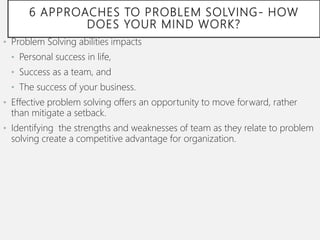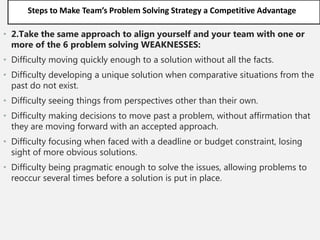6 approaches to problem solving how does your
- 1. APPROACHES TO PROBLEM SOLVING- HOW DOES YOUR MIND WORK? REF-LISA WOODS IN PROFESSIONAL DEVELOPMENT Compiled by Col Mukteshwar Prasad(Retd), Mtech(IITD),CE(I),FIE(I),FIETE,FISLE,FInstOD,AMCSI Contact -9007224278, e-mail – [email protected] for book ”Decoding Services Selection Board” and SSB guidance and training at Shivnandani Edu and Defence Academy
- 2. 6 APPROACHES TO PROBLEM SOLVING- HOW DOES YOUR MIND WORK? • Problem Solving abilities impacts • Personal success in life, • Success as a team, and • The success of your business. • Effective problem solving offers an opportunity to move forward, rather than mitigate a setback. • Identifying the strengths and weaknesses of team as they relate to problem solving create a competitive advantage for organization.
- 3. Six Common Approaches to Problem Solving: • 1: Analytical Problem Solving • An analytical thinker has the ability to • Get into the detail of a problem, • Evaluate all components & perspectives to understand it and • Determine what’s missing. • Analytical thinkers • Ask questions to fill in any gaps to foresee next steps. • Have confidence in their ability and make assumptions & decisions because of their constructive fact finding process. • Although their assumptions are credible & decisions well supported, yet • May not move quickly to a solution in absence of all the facts. • Fact-finding process takes time, • May not offer any opinions unless specifically asked.
- 4. Six Common Approaches to Problem Solving: • 2: Logical Problem Solving • A logical thinker has the ability to • Continuously collect detail and put it into sequence, • To see the big picture & • Evaluate where the problem exists and why. • Using historical data, they infer solutions based on similar earlier situations. • If this worked before it may work again • In the absence of past similar situation may apply adjacent situation (Best fit) to arrive at new solution • 3: Rational Problem Solving • A rational problem solver has the ability to • Take information that is available & • Make assumptions based on that information, • Deduce the most optimal solution based on his personal perspective
- 5. Six Common Approaches to Problem Solving: • 4: Absolute Problem Solving • An absolute problem solver has the ability to see • A problem as black or white and • A solution as right or wrong. • They try to find that solution by seeking an authoritative source that can confirm the answer. • They often have difficulty moving past a problem without affirmation that they are moving forward with an accepted approach. • They infer a solution that worked elsewhere must work in a parallel situation.
- 6. Six Common Approaches to Problem Solving: • 5: Creative Problem Solving • A creative problem solver has the ability to – Envision several outcomes, – Make assumptions as to achieve an outcome & – Willing to take risks because they have confidence in their own judgment. • Creative thinkers start from scratch and are not limited by steps or processes; • They create unique paths and new solutions. • The limitation of creative problem solving is • There is no limit to the creative process. • Struggle for deadline / budget constraint etc. • Because they have difficulty focusing and can lose sight of more obvious solutions.
- 7. Six Common Approaches to Problem Solving: • 6: Positive Problem Solving • A positive problem solver has the ability • To compartmentalize a problem as an individual event and • Seek solutions with an open mind. • Predict improvement and are more open to finding ways of achieving it • They are not restricted by fears or past results • They hook on opportunities to improve and collaborate. • They may not hold situations or individuals accountable when they are required to do so thus • Problems reoccur several times before solutions are put in place because they are not pragmatic enough to solve the issues. • By understanding the different paths, you can open the door to the best problem solving technique for a given situation. • Team Problem Solving Strategy • Chances are that you may have more than one type of problem solver in your
- 8. Steps to Make Team’s Problem Solving Strategy a Competitive Advantage • 1. Align yourself, and each of your team members with one of the 6 problem solving STRENGTHS: • Ability to get into the detail of a problem and evaluate all components & perspectives to understand it and determine what’s missing. • Ability to continuously collect detail and put it into sequence, see the big picture, evaluate where the problem exists and why. • Ability to take information that is available and make assumptions based on that information, deducting the most optimal solution based on personal perspective. • Ability to see a problem as black or white and a solution as right or wrong by seeking authoritative approval & consensus. • Ability to envision several outcomes, make assumptions as to what needs to be done to achieve an outcome & is willing to take risks because they have confidence in their own judgment. • Ability to compartmentalize a problem as an individual event and seek solutions with an open mind.
- 9. Steps to Make Team’s Problem Solving Strategy a Competitive Advantage • 2.Take the same approach to align yourself and your team with one or more of the 6 problem solving WEAKNESSES: • Difficulty moving quickly enough to a solution without all the facts. • Difficulty developing a unique solution when comparative situations from the past do not exist. • Difficulty seeing things from perspectives other than their own. • Difficulty making decisions to move past a problem, without affirmation that they are moving forward with an accepted approach. • Difficulty focusing when faced with a deadline or budget constraint, losing sight of more obvious solutions. • Difficulty being pragmatic enough to solve the issues, allowing problems to reoccur several times before a solution is put in place.
- 10. Steps to Make Team’s Problem Solving Strategy a Competitive Advantage • 3.Discuss the Problem Solving Evaluation Process, Strengths & Weaknesses with your team as a whole, as well as the Individual Evaluation with each team member one-on-one. • Train your team on problem solving mindsets, making it an open discussion amongst them. • Work with each individual to overcome their weaknesses by leaning on other team members who can use their strengths to assist. • Sharing conclusion with the team depends on you and situation • Team members may also decide to share the information on their own. • 4.Now you are now ready to tackle your next business problem! • Once a problem is identified- • Assign the problem to one team member to lead the solution process based on their strengths. • Assign other team members as support based on leader’s weaknesses. • Team approach will get the best, most competitive solution faster.










